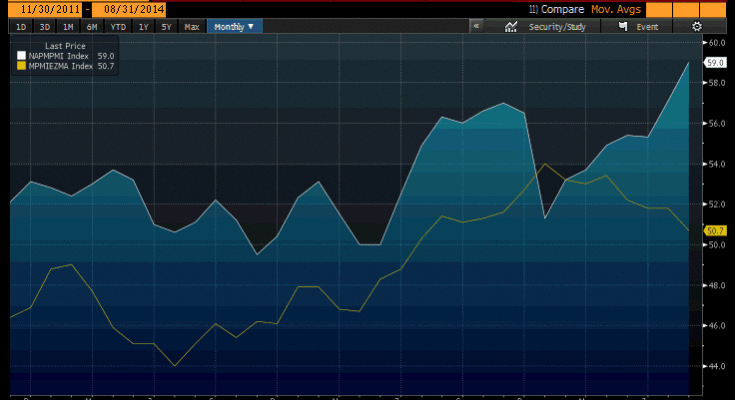
This Great Graphic was created on Bloomberg.  It depicts the US manufacturing PMI (white line) and the eurozone manufacturing ISM (yellow line). Â
There has been a clear divergence since the start of the year.  Briefly, in January, the eurozone reading rose above the US.  This had not happened before, though the eurozone time series only goes back to September 2011. The August prints make for the largest divergence since the eurozone time series began.Â
This lower graph, also created on Bloomberg, shows the CPI readings (US in white and eurozone in yellow).  US CPI is higher than the eurozone CPI by the most since early 2010.  The gap has been widening since the Q4 13.Â

The divergence of inflation and economic activity (using the manufacturing PMI as our proxy) lies at the heart of the divergence in monetary policy.  It is this divergence that has encouraged the amassing of the large speculative short euro position in the futures market and the persistent pressure in the spot market, where the euro has fallen for seven consecutive weeks coming into this month. Â
Technically, the euro looks over-extended, though new lows for the move were recorded earlier today, though today’s range is a little more than a quarter of a cent.  We think the market is turning cautious ahead of the ECB meeting on Thursday. We suspect the market will be disappointed if the ECB does not announce a QE program. An ABS purchase program would understood as a form of QE, we think. We are under the distinct impression that an ABS purchases are more complicated than many observers seem to appreciate, and the removal of obstacles is not completely in the ECB’s domain. Moreover, it seems to be putting the cart before the horse if a QE program is announced before the TLTRO or asset quality review. Â
We think that odds of another cut in rates and some adjustment to the TLTRO to increase the likelihood of greater participation.  This could involve cheaper funding (which is implicit by a repo rate cut) and ensuring that smaller banks that do not have access to the ECB’s facilities, can also participate indirectly through other financial institutions.  Â

